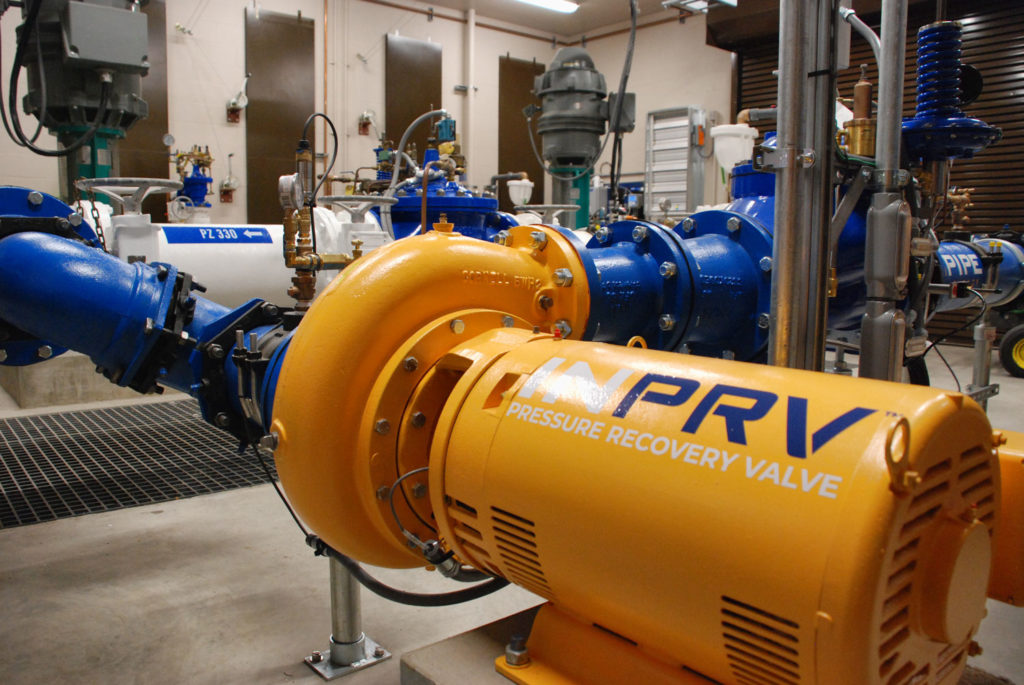Local Government:
Skagit County & Skagit Public Utility District, WashingtonProject:
In-pipe Micro-hydropower ProjectCategory:
Innovative Energy ProjectProject Purpose
Install a micro-hydro system in the municipal water pipelines, which allows for electricity generation from the excess pressure in the pipelines. The system generates clean energy, helps save water, and extends the life of the pipeline.
Project Overview

Skagit Public Utility District (Skagit PUD) is a not-for-profit, community-owned utility with a locally elected board of commissioners. It operates the most extensive water system in Skagit County. The PUD captures and treats 9 million gallons of water every day from its Judy Reservoir and sends it downhill through transmission pipelines to serve around 80,000 customers living in the lower Skagit Valley. Sending piped water downhill creates a lot of pressure, which can cause leaks and prematurely age the water system.
In July 2021, Skagit PUD installed the first pressure reducing valve (PRV) project in Washington state. The In-PRV technology from InPipe Energy is a new intelligent water and micro-hydro system that generates electricity by recovering and using the excess pressure and wasted energy from municipal water pipelines.
By recovering the energy embedded in excess water pressure and converting it into electricity, the 22-kilowatt system can generate up to 94,000 kilowatt-hours (kWh) or more of electricity per year while providing pressure management that helps save water and extend the life of the pipeline. The electricity produced from the In-PRV will be used to offset the power used at Skagit PUD’s East Division Street pump station in Mount Vernon, WA. This will save the district (and its customers) money and replace the equivalent of 1,587 metric tons of fossil-fuel-based carbon emissions annually.
The system is the second installation of an In-PRV system in a municipal pipeline — the first one was installed in Hillsboro, Oregon, in September 2020.
“This project represents a small, scalable public-private partnership to address multiple issues at once…the energy generated from the pump system is more stable than most renewable energy resources due to the long and consistent operating hours of the water system. This presents an opportunity for more generation, even when wind and solar aren’t generating.”
George Sidhu, skagit PUD General Manager
How was the deal structured?

The project was made possible with assistance from Puget Sound Energy, as part of its “Beyond Net Zero Carbon” initiative, and a Coal Transition Board Grant from TransAlta energy company. TransAlta, which is phasing out its last coal-fired power plant in Centralia, WA, by 2025, has committed to supporting local communities and renewable energy development through its Coal Transition Board Grant process.
What were Skagit PUD and Skagit County’s biggest challenges in setting up this project?
System Integration. Initially, due to the uniqueness of the In-PRV system, there were some internal hurdles to overcome with staff, including how the micro-hydro unit would integrate with the PUD’s distribution system. As the operators learned more about the unit’s setup and capabilities, many of those concerns faded away. The local electrical provider also raised concerns about the complexity of integrating into their power system.
What advice would Skagit PUD and Skagit County give other local governments as they pursue climate action projects?
Public-Private partnership. Skagit PUD’s micro-hydro project demonstrates how local governments can partner with their local utility and innovative technology companies to help meet sustainability goals, reduce operational costs, and improve resilience.
Innovative technology. All water utilities deal with pressure in their systems. Other utilities can use this technology to reduce pressure and transform previously wasted energy into sustainable power.
“The world’s water infrastructure is energy and carbon intensive. We see a large, global opportunity for water agencies to meet their mission while also battling the impact of climate change…our In-PRV product helps water agencies offset their energy costs while saving water, reducing carbon, and extending the life of their infrastructure.”
Gregg Semler, president and CEO of InPipe Energy
How does this project fit into Skagit PUD and Skagit County’s broader climate and community goals?
Water agencies often struggle with rising energy costs and aging infrastructure that’s energy and carbon intensive to replace. The precise pressure management system provided by the In-PRV system and energy generation presents a means to save water and extend the life of the water infrastructure, all while addressing the impacts of climate change by reducing carbon emissions.
Additional Information and Resources
- New system produces energy from municipal water pipeline in Washington, US (News article)
- New Energy Recovery System Produces Renewable Energy from Municipal Water Pipeline at Skagit Public Utility District in Washington. (News article)
- Skagit PUD Energy Recovery Project Comes Online (YouTube video explaining the project)
- New Energy Recovery System Produces Renewable Energy from Municipal Water Pipeline at Skagit Public Utility District (Mount Vernon’s announcement of the project)
- System produces renewable energy from municipal water pipeline in WA (News article)
- New energy recovery system produces carbon free electricity (Skagit PUD press release about the project)
- 2020 Average Monthly Bill – Residential (EIA information on WA energy use)
- Hillsboro In-pip Hydroelectric Project (Hillsboro, Oregon, press release)
This project was included on the Renewables Accelerator’s list: 10 of the Most Noteworthy Local Government Renewables Deals of 2021.
